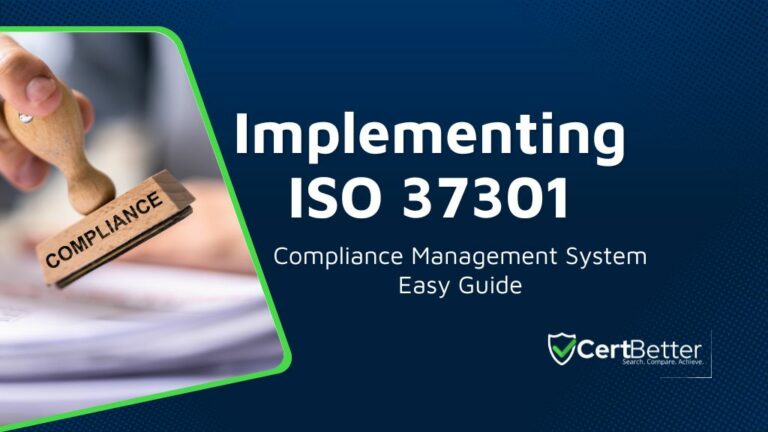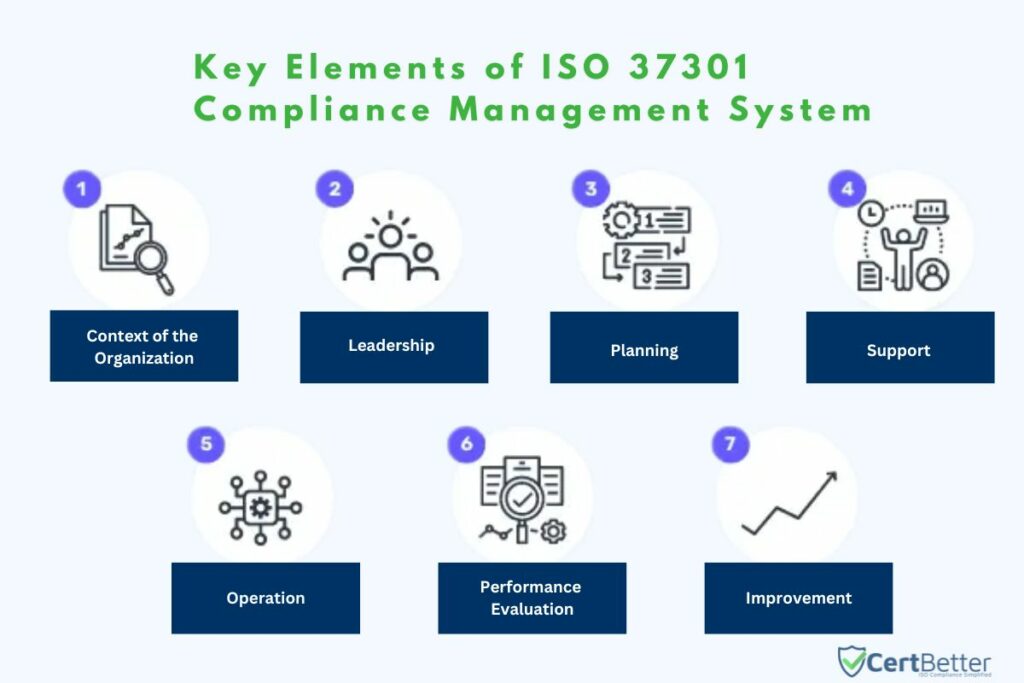Easy Guide to Implementing ISO 37301 Compliance Management System

The International Organization for Standardization (ISO) published ISO 37301 in 2021 to replace ISO 19600 and enhance Compliance Management Systems (CMS) guidelines and policies. This comprehensive guide will give you an overview of ISO 37301:2021 including what the purpose of this standard is, how to implement it in your company and how it can enhance your business operations by limiting your compliance risks.
Do you know CertBetter helps you quickly find ISO 37301 consultants?
What is ISO 37301?
The international standard ISO 37301 (released in June 2021) is used for compliance management systems (CMS). It offers guidelines for establishing, developing, implementing, evaluating, maintaining and enhancing an efficient and adaptable compliance management system within any business regardless of its size or nature. The objective is to protect companies against, recognize and lower compliance risks while also making sure they follow the law, ethical standards and government rules.
Why ISO 37301 is Important for Modern Business?
ISO 37301 is one of the most significant international standards that businesses employ for establishing and maintaining compliance management systems. Any size company can use ISO 37301 as a guide for establishing, constructing, implementing, evaluating, managing, or improving its CMS.
ISO 37301 is important for most businesses because following compliance standards is an ongoing process that needs a structured method and constant tracking.
Using ISO standards and obtaining ISO 37301 certification will make it easier for businesses to develop a CMS that supports compliance. If a business gets ISO 37301 approval, it means they follow all the important rules in their field.
The internal validation and assurance it provides on the steps taken to reduce compliance risks and interruptions is an additional benefit of obtaining ISO 37301 certification.
AI Standard is here: Understanding ISO IEC 42001 Standard for AI Artificial Intelligence Management System
Differences between ISO 37301 and ISO 37001
Regarding compliance management systems, ISO 37301 specifies all of the components. On the other hand, ISO 37001 addresses anti-corruption management, which is a crucial component of effective compliance management.
ISO 37301 and ISO 37001 are both international standards, but they serve different purposes. Due to their shared CMS foundation, ISO 37301 and ISO 37001 are simple to implement and integrate into an organization’s processes.
ISO 37301: Compliance Management Systems
- Purpose: Establish and improve a comprehensive compliance management system.
- Scope: Covers all compliance areas, including legal requirements and internal policies.
- Features:
- Focus on overall compliance.
- Uses a risk-based approach.
- Encourages integration with other management systems.
- Emphasizes continuous improvement.
ISO 37001: Anti-Bribery Management Systems
- Purpose: Prevent, detect, and respond to bribery.
- Scope: Specifically targets anti-bribery measures.
- Features:
- Focus on anti-bribery compliance.
- Includes preventative and responsive measures.
- Emphasizes training and awareness.
Key Elements of ISO 37301 Compliance Management System
Like any other management system standards such as ISO 9001 Quality Management System, ISO 37301 is also based on PDCA (Plan-Do-Check-Act) cycle. Most importantly, principles like good governance, proportionality, transparency, and sustainability form the basis of this standard.
Key elements include:
Context of the Organization – To achieve success, one must have a thorough understanding of the organization, the expectations of stakeholders, the current strategy and system and the methods used to assess risks.
Leadership – A CMS cannot be effective without strong leadership. This includes establishing anti-bribery legislation, having roles and responsibilities in compliance that are clearly defined, and including the governing body. It is critical that upper management demonstrate their commitment to fostering a compliance culture inside the organization.
Planning – Conduct compliance-related actions and planning to address risks, seize opportunities, and achieve anti-bribery or anti-corruption objectives. This includes planning and carrying out risk-based compliance actions to find, stop, and handle potential violations.
Support – Staff may understand their roles and have the necessary abilities with the help of resources, training, communication, and documentation.
Operation – Due diligence procedures that help in preventing bribery and corruption include commitments, gifts, hospitality, contributions, and investigations.
Performance Evaluation – Internal audits and management reviews are two forms of performance evaluation that should be conducted on a regular basis to keep the business running smoothly. In order to find ways to make the CMS better and make sure it stays successful, these evaluations should concentrate on accomplishments, efficiency, and conformity.
Improvement – An essential part of ISO 37301:2021 is continuous improvement. In order to improve their CMS, organizations should handle nonconformities and put corrective actions in place.

ISO 37301 Implementation Guide?
When it comes to meeting all of your commitments, implementing ISO 37301 can be both a challenge and an opportunity. Successful implementation of ISO 37301 requires companies to be aware of potential obstacles, focus on key success factors to set the context for success and follow to a disciplined implementation process to avoid missing any steps.
Latest ISO Standard Guide: Understanding ISO 59004 Circular Economy Standard
How long does it take to implement?
The time to implement ISO 37301 varies by company, typically taking a half year on an average. The duration depends on three factors:
Available resources: The number of employees and the time dedicated to the implementation affect the timeline. Fewer resources lead to a longer implementation period.
Robustness of the Compliance Program: If a company already has an active, robust Compliance Program, it may have up to 40% of ISO 37301 requirements met, needing only adaptations.
Size of the organization: Larger companies or those with multiple units face more complexity and risks, requiring more effort.
Is Implementing ISO 37301 Very Difficult?
Although implementing ISO 37301 is never simple, how hard it is will rely on the resources the business currently has.
ISO 37301 is related to other ISO standards, therefore if your organization has already adopted one, it will be simpler to make the change to ISO 37301. The procedure will be more difficult for individuals who are beginning with their first standard.
Recommended read: Understanding ISO Terminology: Guide to Important Terms and Concepts
Companies that have robust compliance systems will find implementation easier; all they have to do is align their current processes with ISO 37301. Bringing in a consultant who has expertise in ISO standards can help simplify the process even more.
Medium and small enterprises may find the implementation process easier to manage because they have smaller workforces and fewer operational divisions.
Things to Avoid When Implementing ISO 37301
A thorough implementation strategy, sufficient resources, and ongoing staff and top management support are required for ISO 37301 to be implemented. By avoiding the following mistakes, businesses may establish and maintain an effective CMS that makes it easier for them to comply with legal and regulatory requirements, ethical standards, and social obligations:
Lack of commitment from leaders: Without top-level support, the compliance management system will undoubtedly fail. Only with the complete support and endorsement of senior management, who also ensures that all employees understand the significance of compliance, can the standard be successfully applied.
Making things too complicated: It might be difficult to implement and maintain an excessively complex compliance management system. Simplifying the system and focusing on the primary compliance issues are the best way to take action.
Lack of stakeholder involvement: Any successful compliance management system must involve workers, vendors, consumers, and government agencies. Ignoring these stakeholders may lead to lack of buy-in and opposition from the system.
Communication breakdown: The compliance management system can only be effective with good communication. Everyone who is part of the system should understand why it works, what its goals are, and what its benefits are. They should also be kept up to date on any changes.
Lack of proper instruction: The compliance management method must be fully taught to all employees. As part of this training, they must learn what their specific tasks are and how to spot possible safety risks and report any violations they may come across. Compliance issues can happen if employees aren’t taught how to use the system properly.
Inability to adjust to new situations: The compliance management system needs to be flexible enough to adapt to new rules or changes in the way the company does things. Without system adaption, the likelihood of non-compliance rises.
Assuming compliance only happens once: Compliance management is an ongoing process that needs to be improved all the time. The risk of complacency and noncompliance increases when compliance is seen as a one-time occurrence.
What is the difference between ISO 37301 and the Compliance Program?
ISO 37301 and Compliance Programs both aim to ensure organizations follow laws, regulations, and policies, but they differ in scope and application.
ISO 37301
- Scope: It’s an international standard for a comprehensive compliance management system.
- Features: Provides a standardized framework, emphasizes risk-based approaches, promotes continuous improvement, encourages integration with other systems, and requires thorough documentation.
- Implementation: Involves defining scope, identifying obligations, conducting risk assessments, establishing controls, and regular audits.
Compliance Program
- Scope: An internal initiative tailored to the organization’s specific needs.
- Features: Customized to the organization’s risks and regulatory environment, includes policies, training, risk assessments, monitoring, and reporting mechanisms.
- Implementation: Involves identifying laws, developing policies, training, monitoring, and addressing compliance issues.
Key Differences
- Standardization vs. Customization: ISO 37301 offers a standardized framework, while a Compliance Program is tailored to the organization.
- Documentation: ISO 37301 requires extensive documentation; Compliance Programs vary based on organizational needs.
- Integration: ISO 37301 integrates with other ISO systems, whereas Compliance Programs may not.
Which is better: ISO 37301 or Compliance Program?
Thoughtfully, ISO 37301 is the better option since it includes the Compliance Program. Since ISO 37001 applies to the whole organization, you will be implementing measures that touch every level of staff, from entry-level workers to upper management, with the goal of ensuring that all parties are on the same page when it comes to compliance measures. This will allow you to put preventative controls in place across the board and foster a culture of compliance.
And because ISO 37301 is an international standard, when you explain your company’s commitment to compliance, other firms will notice that you value compliance.
Having trouble finding the best ISO 37301 consultant? Find an ISO consultant on CertBetter!
Frequently Asked Questions
Who can implement ISO 37301?
The person in charge of this standard should have intermediate compliance knowledge due to the many legal issues that occur during implementation. You can ask for your employee to be trained in the standard if they possess these traits and are systematic, which are necessary for someone working with management systems.
You can also engage a consultancy to help with the standard’s implementation process. This way, you’ll have an internal resource to learn from the practice and maintain the management system, as well as an outside resource with extensive experience to offer security and an alternative viewpoint on improvements.
Is ISO 37301 Certifiable?
Being a Type A MSS, ISO 37301 can be certified by any recognized certification company. This ensures that it may be used by any organization, no matter its size, industry, level of risk, or worldwide reach, as a certification standard.
Companies with a global presence and a desire to establish a uniform and thorough sustainability management system may find this standard useful.
What is Compliance Management System?
Organizations can more easily comply with legal and regulatory obligations by using a Compliance Management System (CMS), which is a collection of records, procedures, tools, etc. CMSs ensure that the law is followed, hence reducing the chance of harm to consumers.
Is ISO 37301 Certification Mandatory?
No business is required to comply with ISO 37301. Companies in the banking, healthcare, insurance, technology, and other heavily regulated sectors can gain an edge over their competitors by being ISO 37301 certified.
What is the purpose of a uniform CMS standard?
It guarantees that every organization has a suitable CMS when there is a common standard. Holding every business to the same high standards is ensured by establishing a fair playing field. By ensuring that customers are only doing business with companies that have strong and efficient CMS, it also serves protecting consumers.
Conclusion
Now is the ideal moment for organizations to implement ISO 37301. A strong foundation for managing compliance risks and improving overall performance is offered by this standard. Organizations may show their dedication to compliance and gain the trust and confidence of stakeholders by implementing ISO 37301. The first step in streamlining the process is to evaluate the present resources, make use of the current compliance processes, and think about hiring a professional consultant.
- Last updated: June 29, 2024
- CertBetter
Our community of compliance professionals and ISO experts is ready to provide you with insightful answers and practical solutions. Join the discussion now!
- Recommended Reads
- 33 reads
-
Frequently Asked Questions
Understanding ISO Terminology: Guide to Important Terms and Concepts
No posts found
ResetConnect with ISO Certification Consultants
CertBetter makes it easy to find ISO certification consultants and compliance professionals from around the globe.

